 Kwan Yen, slab built clay wall sculpture by Tammy Vitale
Kwan Yen, slab built clay wall sculpture by Tammy Vitale
As promised yesterday, here are some of my thoughts on the business of art:
1. Shows. Can let you travel and then charge it against your taxes as a business expense. But that means you have to have the money in the first place. The best thing about shows is the networking – never go to a show simply because you think you’re going to make a lot of money. Be there to talk with everyone, ask questions, give out cards. Think about your display – it makes a difference (and making that difference will have high start up costs): tent? screens? outdoors, use wire screens so your display doesn’t turn into a kite when the wind blows. Find a way to pack whatever it is you’re selling so that it doesn’t get chipped (ceramic) and dinged (frames). Learn how to pack whatever your carrier is (mine’s an early 80s boxy Mercedes that I pull the back seat out of – she’s great!). Think about a handtruck for moving your wares if they are heavy. Check the show out first if possible. I believe the rule of thumb is: whatever you pay for the booth, you should anticipate 10x that income. Which means you have to have enough product to produce that income.
Galleries. This is a whole college semester. Each one is different. But the best way to approach is to go on-line and see how they like to be approached. Not there? Call and ask. Mostly they like to be approached via a package with you bio, artist statement, other galleries, shows, awards, etc. There is a debate about whether or not using non-juried shows is helpful on a bio. Sometimes galleries have community shows which are more inclusive. Some galleries rent space out and you can do you own show (warning: putting a show on is easy. Getting people to the show is a whole ‘nother thing).
Shops. My favorite. You are going to pay a percentage for the ability to drop your work and have someone else babysit it until it is sold and then send you money – anywhere from 25 – 50% (in my locale. We have one I’ve heard is 60% but she doesn’t support local art anyways). Just plan your prices accordingly. Remember, however, that whatever your price is for the shop needs to be your price everwhere, otherwise you’re going to wind up with a very unhappy shop owner. Do not undercut your shop owners either in shows or on the internet. And oh yes, they will find out. I like shops because they let potential clients look at the art, go home and think about it, and come back and buy it. I always thought everyone was like me: I see it, I love it, I buy it. Well, they aren’t. Some people have to think a while before they drop $400 – $650 on a piece of art. They have to circle it and sniff it for a while. This is why shops are good. They’re also good to be able to refer people to if you’re doing a show (can’t decide today? well, I always have work here…..).
Here are some more links for further research:
My favorite ezine writer (and you can see she has a blog too) delivered to my email regularly: Alyson B. Stanfield, Art Biz. Subscribe. You’ll learn something.
An article on using an art representative or not. This one takes a really long time to come up, so you might want to leave it for when that won’t make you crazy
A reference page for "The New at Art."
An article on art marketing.
More articles on business for creative people.
A college course syllabus on art business (hey – it gives you an idea of things you need to consider!)
And finally, keep up on the latest Warhol copycat , the banksy effect, (as reported by Bizsoltuionsplus) who is making a mint (these kinds of articles are depressing to me but perhaps you’ll find them hopeful…at any rate, it proves to me that making it in art is more about marketing than art – the raw truth).
thought for the day: Antonio Damasio [says] "Perhaps the most important revelation is precisely this: that the left cerebral hemisphere of humans is prone to fabricating verbal narratives that do not necessarily accord with the truth." And Michael Gazzaniga writes: "The left brain weaves its story in order to convince itself and you that it is in full control…The interpreter is really trying to keep our personal story together. to do that, we have to learn to lie to ourselves." These insights, based on solid experimental work, show that we tend to believe our own press releases. Often when we think we’re being rational, we’re being spun by our own thinking. [so pay attention to what you’re thinking…is it true? or is it just your story?] Byron Katie, Loving What Is: Four questions that can change your life



4 Comments
Thanks, Tammy. You have great stuff on here! Will definitely add you to my feeds.
Happy holidays!
is that a goddess you created? love it!
sage
oh and another thing, do you have an rss feed for your blog? I wasn't able to find it. I think you can enable that feature on typepad…it allows people to subscribe to the feed from your blog (sorry if I'm saying stuff you already know!)
this is great tammy! thanks for all the info. hearing your personal experiences is one of my favorite things about your blog!!